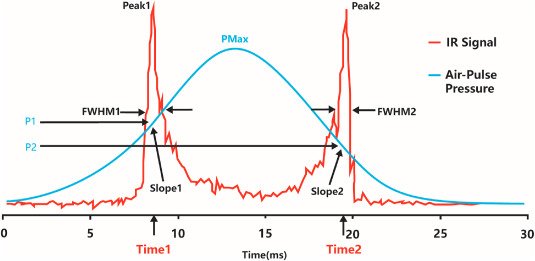Review of In-vivo Characterisation of Corneal Biomechanics
Authors: Lopes, B.T., Bao, F., Wang, J., Liu, X., Wang, L., Abass, A., Eliasy, A., Elsheikh, A.
Journal: Medicine in Novel Technology and Devices
Publication Date: Sep 2021
ORA signal and pressure application profile showing first and second applanation pressures (P1 and P2). IR: Infrared.
Summary:
The cornea is a transparent tissue in the front of the eye that helps focus light onto the retina. Its unique structure allows it to maintain clarity and withstand external pressure. Our latest research focuses on the in-vivo (in the living body) study of corneal biomechanics and three devices currently available for clinical use: the Ocular Response Analyzer (ORA), the Corvis ST, and the Brillouin Optical Scattering System.
Understanding corneal biomechanics is crucial because changes in the cornea's structure can affect its ability to focus light and maintain its shape. This can result from the natural aging process, diseases like keratoconus, or treatments such as laser vision correction surgeries.
Our review of these three devices delves into their principles, main parameters, and strategies for improving accuracy in intraocular pressure (IOP) measurement, corneal ectasia diagnosis, evaluation of corneal cross-linking procedures, and planning of corneal refractive surgeries.
ORA and Corvis ST have already shown success in accounting for corneal biomechanical impact on IOP measurement. However, their initial parameters could not be directly linked to standard biomechanical properties. This issue was addressed with the development of the stress-strain index in the Corvis ST, which estimates corneal stiffness at various stress or IOP levels.
Meanwhile, Brillouin microscopy has made significant progress, leading to the development of a clinically compatible device being prepared for commercialisation. As this new technology continues to evolve, its clinical value will become clearer in the coming years.
Our research findings highlight the rapid advancements in corneal biomechanics study and the potential for even more progress in the near future. We expect technologies to emerge that can measure standard biomechanical properties with less influence from factors such as corneal geometry, intraocular pressure, surface humidity, and atmospheric pressure.
By understanding and effectively measuring corneal biomechanics, we can improve the diagnosis and treatment of various eye conditions, ultimately enhancing patients' vision and quality of life.

